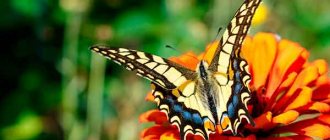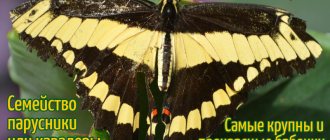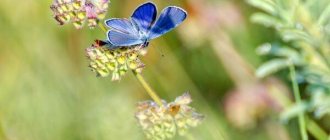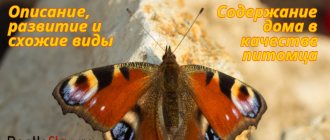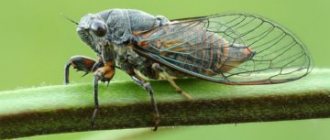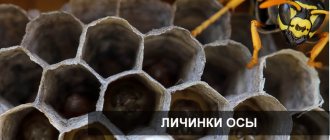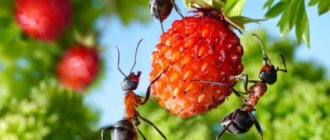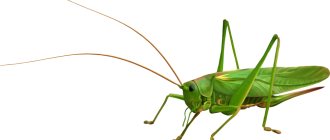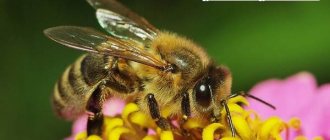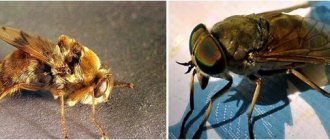Hawkmoth is a butterfly that looks like a hummingbird. She seems to be hovering over the flowers, quickly moving her wings. The colors of the representatives of this family are so diverse and original that it may be difficult to immediately guess which insect is in front of you. One of the main distinguishing features of the hawk moth is its long proboscis, which most often exceeds the size of the insect’s body. A video of the development of the caterpillar will be at the end of the article.
This unusually colored butterfly is a frequent hero of horror films and books. Why do superstitious people feel real trepidation at the sight of a small insect, and should summer residents who discover a hawkmoth pupa fear for their harvest?
In total, about 1,200 species of such butterflies are known, some of which are listed in the Red Book . In Russia you can see 50 species. How to understand that this is a hawk moth in front of you? Should you be afraid for the harvest if you find an uninvited guest at your summer cottage?
Description and appearance
The hawk moth butterfly is usually large or medium in size. Its body with a long proboscis of the Lepidoptera order has a cone shape at the end and is pointed, its wings are elongated and reach a span of 30 to 175 mm. The apices of the long antennae are pointed and hook-shaped. The eyes are round in shape and covered with a tuft of long scales. The proboscis is significantly longer than the body - it can be several times larger in size, but in some species it is short.
The leader in proboscis length among all insects is the butterfly Amphimoea walkeri. The proboscis of this South American species is sometimes 4 times larger than the body and measures 28 centimeters.
The hawk moth hovers over the flower.
The labial palps are curved upward. They are covered with scales on the outside, but there is no such covering on the inside. On the paws you can see short spines arranged in several rows. The abdomen has scales that gather at the end in the shape of a brush or tassel. The length of the hind wings is one and a half times greater than their width, and even in the photo a significant bevel towards the rear edge is visible to the naked eye.
Hawkmoth eggs are oval and measure approximately 1.5 by 1.2 mm. The color is usually pastel: it can be pale green or blue. The eggs are left on food plants, and the butterflies choose the underside of the leaves.
The hawkmoth caterpillar is distinguished by its large size, five pairs of legs and bright coloring - it is decorated with oblique stripes and spots resembling eyes, and individual hairs can be seen on the surface. Its length is initially up to 12 mm, while caterpillars of the fourth instar can grow significantly and be from 40 to 55 mm. Their weight is approximately 4 g.
Hawkmoths are real gourmets - they usually feed on either just one type of plant, or several, but closely related ones . You can see caterpillars both on trees and shrubs, most often in the dark - they are active in the evening and at night. However, some species are awake during the day.
The hawk moth pupa is distinguished by a characteristic elevation at the rear end, which is shaped like a horn. It is smooth and shiny. Weight varies from 7 to 12 g, color in the first hours after pupation ranges from yellow to cream, sometimes with a green tint, and later turns red. The pupal stage lasts about 30 days.
In the caterpillar stage
What does the hawk moth eat? Some species are pests that can cause harm to broad-leaved and coniferous trees in forests, and to stone fruit and fruit crops in gardens . But don't worry. The hawk moth caterpillar, although not beneficial, will not cause serious damage to the crop, and it is not worth fighting it.
This insect, similar to a hummingbird, is heat-loving. Most species are active migrants. The habitat is wide. Butterflies often move to other territories that are located north of the places where they were born. At the same time, hawk moths can easily overcome real obstacles on the way - for example, mountains that rise 3500 meters above sea level .
Butterfly with beak
There are no hummingbirds in our area, but I didn’t find another more plausible explanation for myself then. Quickly flapping its wings, this creature hovered over the flowers and collected nectar from them with a long curling proboscis. The spectacle was mesmerizing...
Features and lifestyle
How to understand that this is a hawk moth butterfly? Pay attention to its features:
- Adults can be up to 11 cm in length, with a proboscis up to 10 cm.
- The speed of movement of the hawk moth is up to 50 km per hour.
- Butterflies have fantastic colors.
- The hawk moth larva reaches 12.5 cm.
- The horn comes in different colors depending on the type of insect.
- Before the pupa turns into a butterfly, a color change occurs.
- Hawkmoth looks like an alien creature - his “outfit” can be so unusual.
Benefit or harm
The hawk moth is a rather neutral insect that can cause some harm, but also brings benefits.
Only tobacco hawk moth can significantly harm tomatoes and other nightshades.
But positive properties :
- is a pollinator;
- used in neurobiology;
- grown for reptile food;
- live at home and create collections.
The African hawk moth is the only pollinator of the Madagascar orchid. Only this species has such a long proboscis, about 30 cm. He is the only pollinator!
Should summer residents be afraid of hawk moth?
The basis of the diet of this species is fragrant nectar . Therefore, in areas where there are many flowers and shrubs, they are more common. You can see how the hawk moth seems to hover over a flower in a flower bed. They appear in the garden extremely rarely - usually isolated cases are recorded. The population size changes significantly every year and largely depends on weather conditions. So in cold years there are significantly fewer hawk moths, and in warm years the number of insects increases sharply.
The caterpillars do not cause serious damage to plantings - they feed on young leaves, but not on a significant scale, so the plants quickly recover. The accumulation of such insects is very rare. Therefore, if you see a caterpillar, then there is no need to worry about the harvest; it is better to just carefully move it from your plot to the meadow, because this insect is listed in the Red Book.
Eating
Since ancient times, it has been believed that the hawkmoth moth is a harbinger of serious troubles. Most likely, the reason for such superstitious fears and hostility lies in the appearance of the butterfly. On the back of some species you can see an ominous pattern - as if a skull and crossbones are depicted on the body. To see what a hawkmoth looks like, you can search for photos using the query “hawkmoth moth photo.” The second reason, which has given rise to a lot of speculation, is the unpleasant squeak of an insect.
Linden hawk moth (Mimas tiliae)
This caterpillar was caught on a linden tree, and when caught it was approximately the same green color as our previous hero. However, by the time of the photo shoot, she had noticeably changed her color to green-yellow. If I had read about this caterpillar earlier, I would have realized that it was already about to pupate - in the linden hawkmoth this is preceded by a change in color.
If I had immediately planted the caterpillar in the leaves and not touched it again, then perhaps I would now still have a pupa of the linden hawk moth. But I did not allow the poor creature to calmly carry out its biological program. While I was replanting, while I was taking photographs...
A day later, the caterpillar fell into a stupor, and a day later it became clear that I couldn’t see the hawkmoth pupa, because it didn’t look like a pupa at all, but like the corpse of a caterpillar that tried to make the transformation, but failed:
So, nothing worked out with the linden hawkmoth. Let's at least see what it might look like (photo from Wikipedia):
Did you like the article? Have questions? Want to inspire the author? Leave a few comments! PS: Don't forget to visit my other website:
The entry was published in the Insects section. Bookmark the permalink.
Hawkmoths in culture
For superstitious people, meeting a hawk moth is a frightening event. A butterfly called "death's head" has become the heroine of creepy legends and stories. This insect has been blamed for disease, death and even war. Some beliefs are still alive - the Mexicans believe that if a scale from a hawk moth's wing accidentally gets into the eye, you can even go blind.
Mentions of the scary butterfly can be found in books and films. So in the film “The Silence of the Lambs” by Jonathan Demme, a maniac puts a hawkmoth pupa into his victims’ mouths. In the novel on which the film was based, a different species was chosen - Acherontia styx, but in the film we see the death's head hawkmoth.
Edgar Poe mentions this butterfly in the story “The Sphinx” - where the insect was crawling along the web on the window. Alexander Belyaev refers to the same creepy image in the story “The Death's Head”.
Van Gogh called one of his works “Death's Head Hawkmoth.” However, he mistakenly depicted another butterfly, called the Pear-Eyed Peacock. A new name was given to the painting at the Artist's Museum in Amsterdam, renaming it “Imperial Night Butterfly”.
Is it possible to breed butterflies at home?
In order for the hawkmoth butterfly to live at home, you need to provide it with a temperature of + 22 degrees, and the duration of daylight is at least 14 hours. An insectarium is used for breeding. You need to spray the container regularly to increase humidity. The caterpillars should have a bowl or box; it is recommended to cover its walls with mesh so that the larvae can crawl along it. The container cannot be tightly closed; there must be ventilation.
During the pupal stage, it is necessary to ensure sufficient soil thickness. This could be peat or moss. The soil should always be moist, but not wet. You can feed with water with added honey. Plants are also used if caterpillars are present.
The container with water must be covered, otherwise the larvae may fall from it and drown.
It is especially beneficial to place flowering plants in a large container. Then the food will be natural. If you comply with the growing requirements, you can observe all stages of hawk moth development.
How long does this butterfly live?
The hawk moth insect does not live long. Its life cycle consists of four phases. First, the female must lay an egg, from which a larva emerges after 2-4 days. The caterpillar turns into a pupa, and later an adult is born. To attract the attention of the male, a special pheromone is released. After mating, which lasts several hours, the butterfly lays eggs on the plants.
The lifespan of these insects varies depending on the species:
- the tobacco hawk moth lives for about a month;
- some species live only a few days and die after new eggs are laid. At the same time, they feed on the reserves that were made earlier. The full classification of butterflies is here.
Wine Hawkmoth (Deilephila elpenor)
The caterpillar was found eating grape leaves. She was fat, elastic and green, with a horn and four false eyes in the front.
Friends! This is not just an advertisement, but my, the author of this site, personal request.
Please join the ZooBot group on VK. This is pleasant for me and useful for you: there will be a lot there that will not end up on the site in the form of articles. She behaved actively and did not refuse food in captivity. I also didn’t mind being photographed in different poses. Click on the pictures - they have a lot of details!
But a couple of days later, she disappeared from sight. Carefully turning over the leaves piled on the bottom of the aquarium, I discovered a certain conglomerate: the leaves were clearly glued together. In the depths of the shelter, the strangely modified body of a caterpillar, covered with mucus, lay motionless.
After a day or two, I decided to see what happened in the house of leaves. As soon as I started raking them, I felt something twitch energetically inside. The leaves were glued together perfectly, but what can one poor caterpillar oppose to the destructive power of the human mind?
I don’t think it will be a revelation to anyone that there was a pupa .
The front part of the pupa is completely rigid, the rear part consists of three movably connected segments and ends with a horn. When a doll is nervous, it can beat intensely, frightening the offender and jumping from place to place:
Here's what struck me most. Next to the pupa in the leaves lay the blackened and dried head and front part of the body of a former caterpillar with six horny legs. I never thought about the fact that when a caterpillar turns into a chrysalis, it throws off its head! (“And what does she think with???” - this begs an idiotic question, from which, however, another follows: “Do caterpillars think in principle?”)
The idea for the demotivator is born by itself: “Don’t be a larva! Don't lose your head!
Now all that remains is to put the pupa in a secluded, cool place, and perhaps in the spring I will be able to watch the most exciting stage of the transformation: the birth of a butterfly.
Added six months later: it was possible to observe the birth of a butterfly, although a little earlier than expected. For details and photos, click on the picture:
The medium wine hawk moth is the one that hatched in me six months later. Details.
And now the second story, tragic...
Hawk Moth Breeding
Hawkmoth butterflies of most species are easily bred in captivity. Usually an aquarium is installed at home, with branches of deciduous trees placed inside it. The caterpillars are planted on them. Soil and pebbles are placed at the bottom. In winter, the bottom of the aquarium is covered with sphagnum or wet sawdust. For hatching, the aquarium must be illuminated for at least 14 hours a day. The required humidity is maintained using a spray bottle. Read more about what a Butterfly Farm is.
Nutrition
This moth's favorite treat is flower nectar. How he gets it was mentioned a little higher. It is worth adding that this is not at all easy to do. Such stunts are considered aerobatics.
Hawkmoth collecting nectar from a flower
In order to get the honey that butterflies love, they have to fly over the hive and pretend that they are bees. A funny and interesting show. It is not difficult for a hawk moth to use its proboscis to pierce a honeycomb and feast on honey from it.
Types of hawk moths
Wine hawkmoth (also called "grape hawkmoth" or "rose hawkmoth") is found on grapevines. This species is distinguished by its bright color, large size and sharp spine.
The lilac hawk moth is one of the largest butterflies that adorns the hawk moth family. Its wingspan ranges from 90 to 120 mm . The hind wings are colored pink, and rings can be seen on the abdomen, some of which are also pink, while others are brown. The lilac hawk moth differs from other species in its proboscis - its length is approximately the same as the insect’s body. The caterpillar can be of two colors - green or purple.
Hawkmoth is a hummingbird of the middle zone. Indeed, as you can see from the photo, it won’t be difficult to find common features between a butterfly and a bird. It's a joke of nature - hummingbirds are the tiniest birds, their weight is usually no more than 2 g, and hawk moths are the leaders among butterflies in size. While feeding, insects do not sit on flowers, but seem to hover over them, quickly flapping their wings. It seems that a tiny bird is hovering over the bud. In central Russia, one of the most common species is the bedstraw hawk moth.
The linden hawk moth is easily recognizable due to its front wings with jagged edges, the span of which can be from 60 to 80 mm. And here we have photographs of the largest butterflies in the world. Color ranges from olive green to rust with irregular dark spots. The hind wings are yellow ocher. The caterpillar of this species is green with red and yellow stripes. You can see it in summer on birch, alder and linden trees.
The moth hawk moth is not protected from the dangers that await it in its natural habitat everywhere. For example, wasps and moths can lay eggs on the surface of the body of a butterfly or pupa. The emerging parasites use the internal organs of the hawk moth as food. The night hawk moth can also be killed by chemical insecticides used by humans, as well as be eaten by birds. Therefore, the insect is forced to defend itself, sometimes using unusual methods. For example, a hawkmoth larva can easily feign death during a bird attack. By the way, here is a list of all moths.
Sometimes caterpillars take threatening poses to scare away enemies - the front part of the body rises menacingly, the insect freezes in this pose. In case of danger, the hawkmoth butterfly can strongly inflate its abdomen.
General information
Hawkmoths do not have a specific type of activity. Some varieties of hawk moths prefer to be active at night, while others prefer to be active in the morning and during the day.
This type of moth is quite large: the wingspan can reach 150 millimeters, and the body is about 100 millimeters long.
Although from a number of moths the dwarf hawk moth is distinguished, the wingspan of which reaches only three centimeters. Due to their heavy weight, moths cannot stay on the flower petals, which is why they prefer to feed by fluttering over the flower.
Interesting facts about hawk moths
Hawk Moth is distinguished not only by its bright and memorable coloring. Some facts about this insect are amazing:
- The death's head butterfly is a real intruder in the world of insects. The hawk moth robs the bees - it flies up to the hive and begins to buzz characteristically, then pierces the honeycomb with its proboscis and feasts on honey. But sometimes the bees understand the trick, pounce on the robber, bite him to death and then mummify him in the hive.
- Another feature of the species is that in times of danger it begins to squeak loudly and desperately.
- In a minute, an insect can cover a distance that is 25 thousand times greater than its body.
- In the Middle Ages, the lilac hawk moth was terribly feared because it was considered a harbinger of death.
- From Latin the name of the wine hawkmoth (“porcellus”) is translated as “piglet”. From a distance, the insect appears to be completely pink.
Corpuscle
Moths have a thick body that protrudes slightly beyond the wings. Most often, the abdomen of moths grows with a mass of hairs, which in the lower part of the body become tangled and even braided.
The body has a lot of powerful muscles that help the insect fly quickly: by the way, hawk moths are the fastest butterflies in the world.
A species of butterfly such as the northern hummingbird can not only quickly cover long distances, but also move backwards, right and left.
Hawk Moth Guard
The diversity of hawkmoth species is amazing, but the population is declining. This is influenced by a number of factors:
- the number of birds that feed on caterpillars is increasing;
- bushes are cut down and grass is burned;
- feed crops are treated with substances that are toxic to butterflies.
In Russia, the most favorable conditions for hawk moths are in the Transcaucasus - thanks to the mild climate, the pupae endure winter more easily. Hawkmoths were included in the Red Book back in 1984.
In some regions where butterflies are critically endangered, insecticide use is being reduced. In addition, the number of plants burned is limited, because they may contain hawkmoth pupae. These simple but effective measures can save rare species and help increase the number of beautiful species.
Breeding at home
Even experts find it difficult to predict the number of these amazing butterflies. In addition to climatic factors, their population is influenced by regular migrations. In May and June, you can notice the first moths, which consist almost entirely of migrants arriving from southern countries. The butterflies that emerge from the pupa partially remain for the winter, but most of them will go south.
To breed house moths, you need to create optimal conditions. It is best to keep such insects in a special insectarium. But if such a device is not available, then you will have to create the following conditions yourself:
- Maintain optimal humidity. Near the butterflies you need to periodically spray warm water from a spray bottle.
- For lighting, directional light lamps can be used.
- Use ventilation holes to ensure continuous access of fresh air.
- For caterpillars, you need to prepare a spacious cage, the volume of which depends on the number of larvae. It is better to equip the walls of this product with a fine mosquito net so that the caterpillars can crawl without slipping.
- Butterflies can only feed on special food plants. Branches with leaves must be placed in a vessel with water, but the liquid itself must be covered. Otherwise, the caterpillars may die. If it is not possible to regularly renew the greens, you can use specialized artificial food.
Hawkmoths need to be fed during the day, since in the dark they fly and do not eat. In addition, not all species of these butterflies need food. As adults, it eats wine, bedstraw, tobacco, bindweed, oleander and lilac species. Linden, ocellated and poplar hawk moths do not feed.
Habitat of the hawk moth butterfly
The hummingbird butterfly is a heat-loving insect, preferring to avoid regions with cold climates. Almost all species are distributed in tropical countries in the following areas:
- Countries of America (both continents).
- Russia, its warm regions.
- Africa and Australia.
You can meet the butterfly in European countries where warm and temperate climates prevail.
Appearance
A drawing that you can try to repeat if you wish.
Gabriel has blond, slicked-back hair and dark blue eyes.
He wears black glasses, a white jacket, red pants, and a striped red and white tie that hides his Miracle Stone. Like Hawkmoth, his eyes are purple. He wears a dark purple shirt with a black vest on his chest. Around the neck is a light purple bow in the shape of a butterfly with a purple button in the center. He also wears black pants and black gloves. His face is hidden by a large black mask. Every time he akumatizes someone, a bright pink butterfly-shaped outline appears in front of his face and around his eyes, which helps him create contact with the akuma victim.
As the Collector, he wears a black jumpsuit with sleeves to the elbows and shoes of the same color with white heels with black stripes. The villain's skin is light purple and his eyes turn red.
Image with colored pencils.
Capabilities
Judging by the fact that the Gabriel brand is one of the most prestigious and famous in all of Paris, Gabriel is an excellent fashion designer. Most likely, he also has entrepreneurial talent, which helps him competently and wisely manage his own company.
Picture of Gabriel with Nuuru.
Like Hawkmoth
Gives people various magical powers through Akum butterflies. Akumas were originally created to fulfill people's wishes, but Hawkmoth began to use these powers to his advantage. He is also capable of akumatizing himself if necessary. In close combat he uses a sword inside a cane, although he prefers to remain in the shadows.
Like a Collector
The collector can “catch” people and objects with his sketchbook. The villain throws it, and when he touches something, it dissolves, remaining on one of the pages as a motionless drawing, and the sketchbook itself returns to the owner like a boomerang. In addition, the Collector can erase captured objects from the sketchbook (when he discovered that he had captured a chair, he waved his hand across the page to either return the chair or permanently erase it. Which of the two is not shown in the series). The Collector can also use it for protection by opening it and holding it in front of him. Thus, anyone who gets close to the villain will fall into a trap.
Fantasy, what the antagonist would look like in his youth.
In addition, the Collector has enhanced speed, agility, and strength, like most other akumatized villains.
Like Scarlet Hawkmoth
Any number of Akum can use a cane. This was shown in the episode "Catalyst". But he also did not lose his normal abilities.

